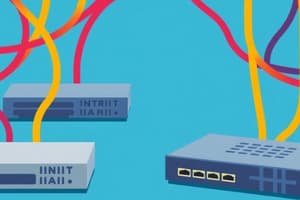Podcast
Questions and Answers
What is a primary advantage of using a bridge in a network?
What is a primary advantage of using a bridge in a network?
- It creates multiple broadcast domains.
- It operates exclusively at the network layer.
- It connects different network topologies. (correct)
- It increases collision domains.
Which statement best describes the role of a gateway in networking?
Which statement best describes the role of a gateway in networking?
- It connects two different network configurations. (correct)
- It amplifies signals across long distances.
- It filters traffic within a single broadcast domain.
- It operates at the physical layer of the OSI model.
Which disadvantage is associated with using a bridge?
Which disadvantage is associated with using a bridge?
- Inability to create different networks.
- Slow processing speed due to MAC address analysis. (correct)
- High security features.
- Increased operational simplicity.
How do bridges impact bandwidth in a network?
How do bridges impact bandwidth in a network?
What is a common limitation of using bridges in a network?
What is a common limitation of using bridges in a network?
When comparing hubs and bridges, which statement is true?
When comparing hubs and bridges, which statement is true?
In which scenario is a gateway necessary?
In which scenario is a gateway necessary?
Which feature of a bridge can help manage data packets more efficiently?
Which feature of a bridge can help manage data packets more efficiently?
What mode of operation does a hub use for data transmission?
What mode of operation does a hub use for data transmission?
Which layer of the OSI model does a hub operate at?
Which layer of the OSI model does a hub operate at?
What is a major advantage of using a switch instead of a hub?
What is a major advantage of using a switch instead of a hub?
How does a switch determine the port to forward a data packet?
How does a switch determine the port to forward a data packet?
What is a limitation often associated with switches?
What is a limitation often associated with switches?
Which of the following is true regarding traffic management in hubs versus switches?
Which of the following is true regarding traffic management in hubs versus switches?
What makes switches more efficient than hubs in network traffic management?
What makes switches more efficient than hubs in network traffic management?
In which scenario would a hub be most preferable over a switch?
In which scenario would a hub be most preferable over a switch?
What is the primary function of a hub in a network?
What is the primary function of a hub in a network?
Which of the following statements correctly differentiates a router from a hub?
Which of the following statements correctly differentiates a router from a hub?
What topology is commonly associated with the use of hubs?
What topology is commonly associated with the use of hubs?
Which of the following best describes the role of a switch compared to a hub?
Which of the following best describes the role of a switch compared to a hub?
In a scenario where an HR employee sends a file to the IT department, what role does the router play?
In a scenario where an HR employee sends a file to the IT department, what role does the router play?
What is a potential drawback of using a hub in a networking environment?
What is a potential drawback of using a hub in a networking environment?
In the context of LANs, what is the primary advantage of using a router over a hub?
In the context of LANs, what is the primary advantage of using a router over a hub?
Flashcards
Bridge (Networking)
Bridge (Networking)
A device connecting multiple LANs to a larger LAN.
Bridge function
Bridge function
Connecting different LAN topologies or segments; improving bandwidth by creating separate collision domains.
Bridge Layer
Bridge Layer
OSI model's data link layer; a two-switch level part in network architecture.
Gateway
Gateway
Signup and view all the flashcards
Network Aggregation
Network Aggregation
Signup and view all the flashcards
Gateway Security
Gateway Security
Signup and view all the flashcards
Protocol Converter
Protocol Converter
Signup and view all the flashcards
Scalability Concerns (Networking)
Scalability Concerns (Networking)
Signup and view all the flashcards
Hub Function
Hub Function
Signup and view all the flashcards
Hub Mode
Hub Mode
Signup and view all the flashcards
Switch Function
Switch Function
Signup and view all the flashcards
Switch Operating Layer
Switch Operating Layer
Signup and view all the flashcards
Switch MAC Addresses
Switch MAC Addresses
Signup and view all the flashcards
Switch Packet Forwarding
Switch Packet Forwarding
Signup and view all the flashcards
Switch Advantages
Switch Advantages
Signup and view all the flashcards
Switch Disadvantages
Switch Disadvantages
Signup and view all the flashcards
What is a Router?
What is a Router?
Signup and view all the flashcards
How does a Router work?
How does a Router work?
Signup and view all the flashcards
What is a Hub?
What is a Hub?
Signup and view all the flashcards
What is the main function of a Hub?
What is the main function of a Hub?
Signup and view all the flashcards
How does a Hub differ from a Switch?
How does a Hub differ from a Switch?
Signup and view all the flashcards
What does a Hub operate at?
What does a Hub operate at?
Signup and view all the flashcards
Why are Hubs still sometimes used?
Why are Hubs still sometimes used?
Signup and view all the flashcards
What is Star Topology?
What is Star Topology?
Signup and view all the flashcards
Study Notes
Hardware Devices in Computer Networking
- Routers: Connect multiple networks, directing data packets to their destinations. They act like traffic directors, ensuring efficient data transmission (e.g., emails, web pages).
- Routers operate at the Network Layer of the OSI model.
- A router checks its routing table to determine the best path for data.
- Routers connect to several host systems through interfaces.
- How Routers Work (Example):
- Employee in HR sending a file to IT: The HR computer sends the file to the router. The router checks its routing table and sends the file to the IT computer.
- Employee in IT accessing cloud software: The IT computer requests the cloud service from the router. The router sends this request to the ISP, which delivers it to the cloud. The cloud sends a response back through the router to the IT computer.
- Hubs: Connect multiple devices on a local area network (LAN).
- Data is broadcast to all ports (all connected devices).
- Operate in half-duplex mode (only one direction of data flow at a time).
- Used in star topology where devices connect to a central hub.
- Switches: Connect multiple devices on a local area network (LAN).
- Operate at the Data Link Layer (Layer 2) of the OSI model.
- Learn MAC addresses of connected devices and forward data only to the intended recipient.
- Operate in full-duplex mode (data can flow in both directions simultaneously).
- More efficient and less prone to collisions compared to hubs.
- Bridges: Connect multiple LANs to a larger network.
- Improve bandwidth and create separate collision domains.
- Act as a layer of two switches to connect multiple LAN segments.
- Gateways: Connect two different network configurations (e.g., two different protocols).
- Act as protocol converters, ensuring smooth communication between networks.
- Manage data entering and exiting the network.
- Used to analyze data packets and determine appropriate routing paths.
- Amplifiers: Increase signal strength to extend the range of data transmission.
- Repeaters: Regenerate signals for longer distances, without modifying it.
- Suitable for both digital and analogue signals.
- Essentially act as signal boosters.
Studying That Suits You
Use AI to generate personalized quizzes and flashcards to suit your learning preferences.




